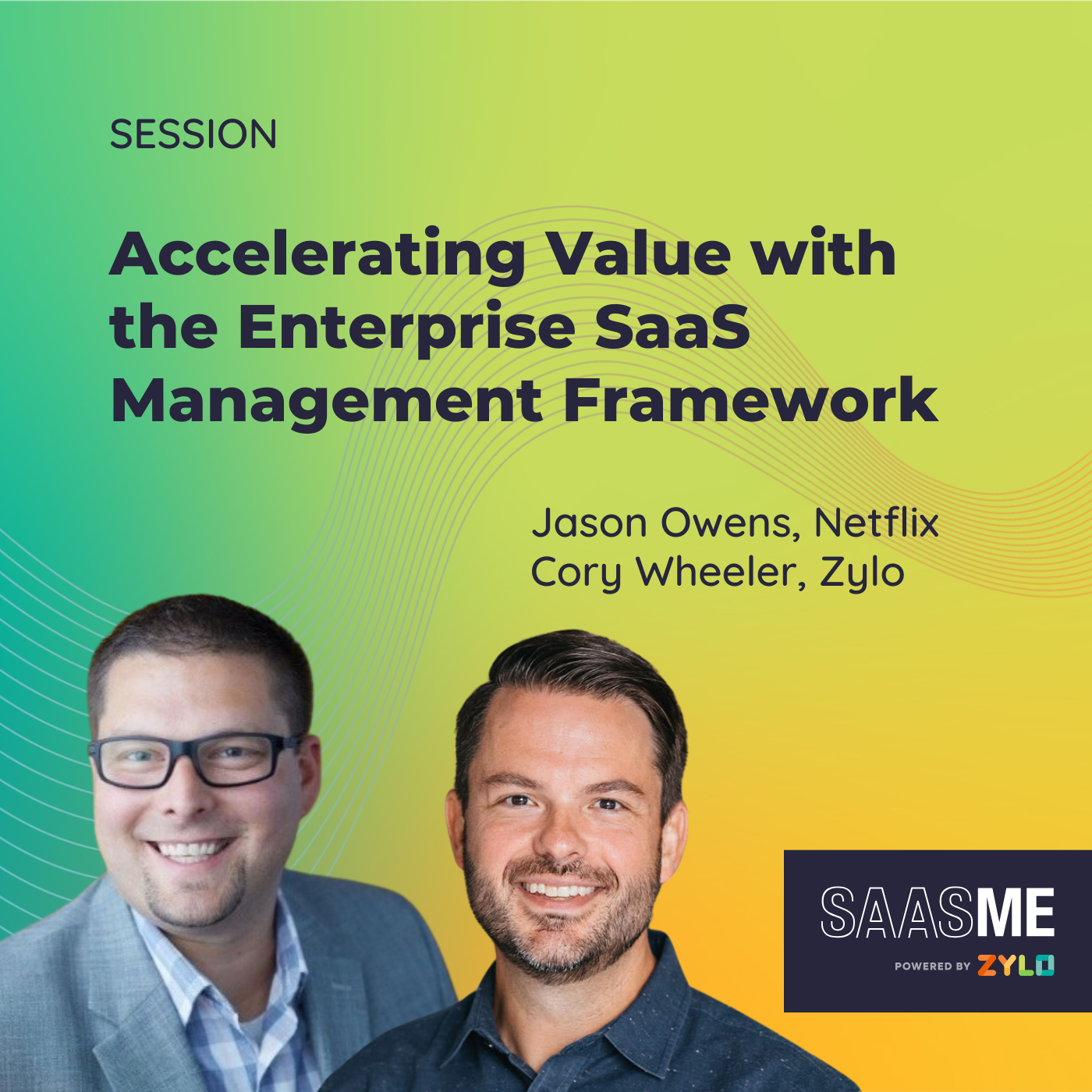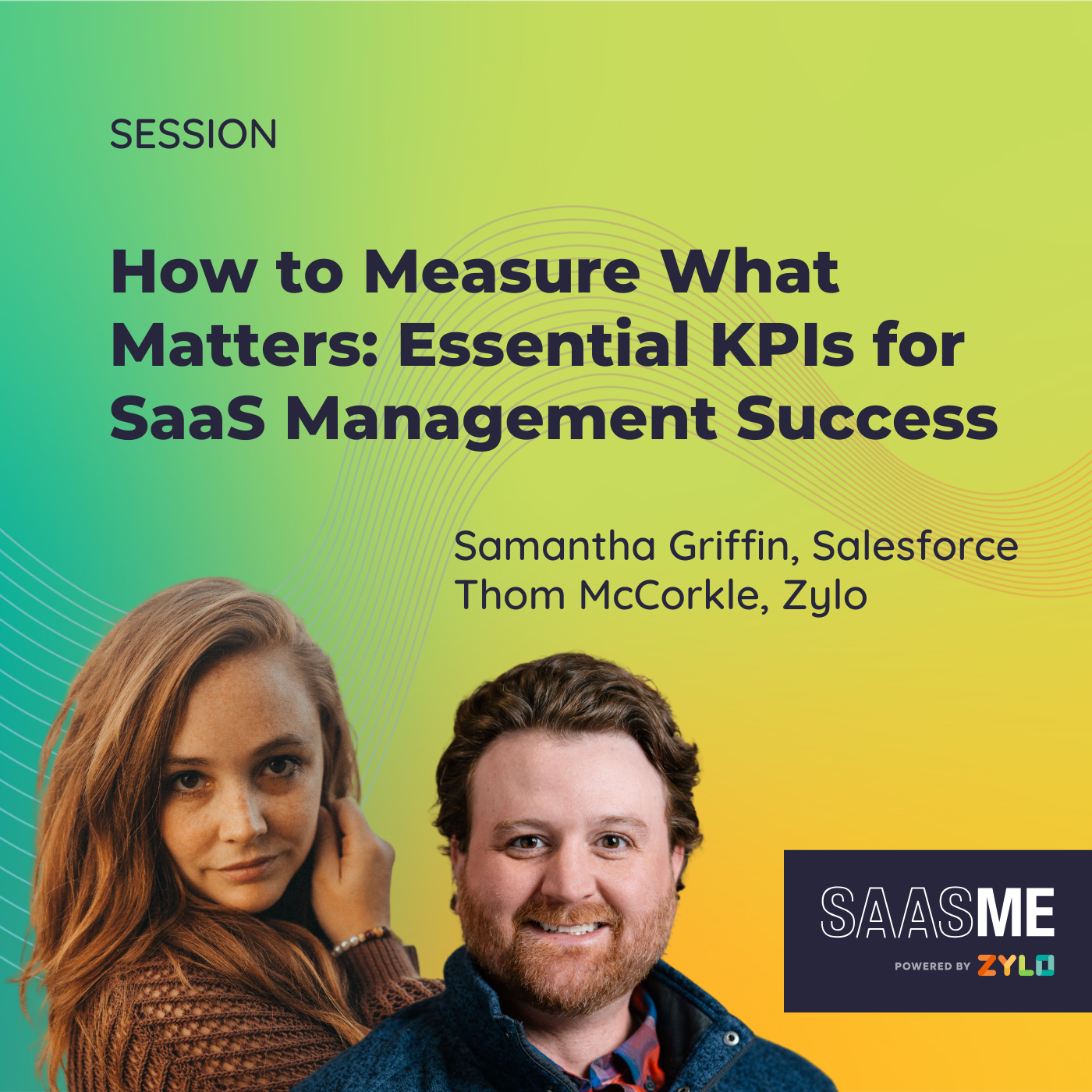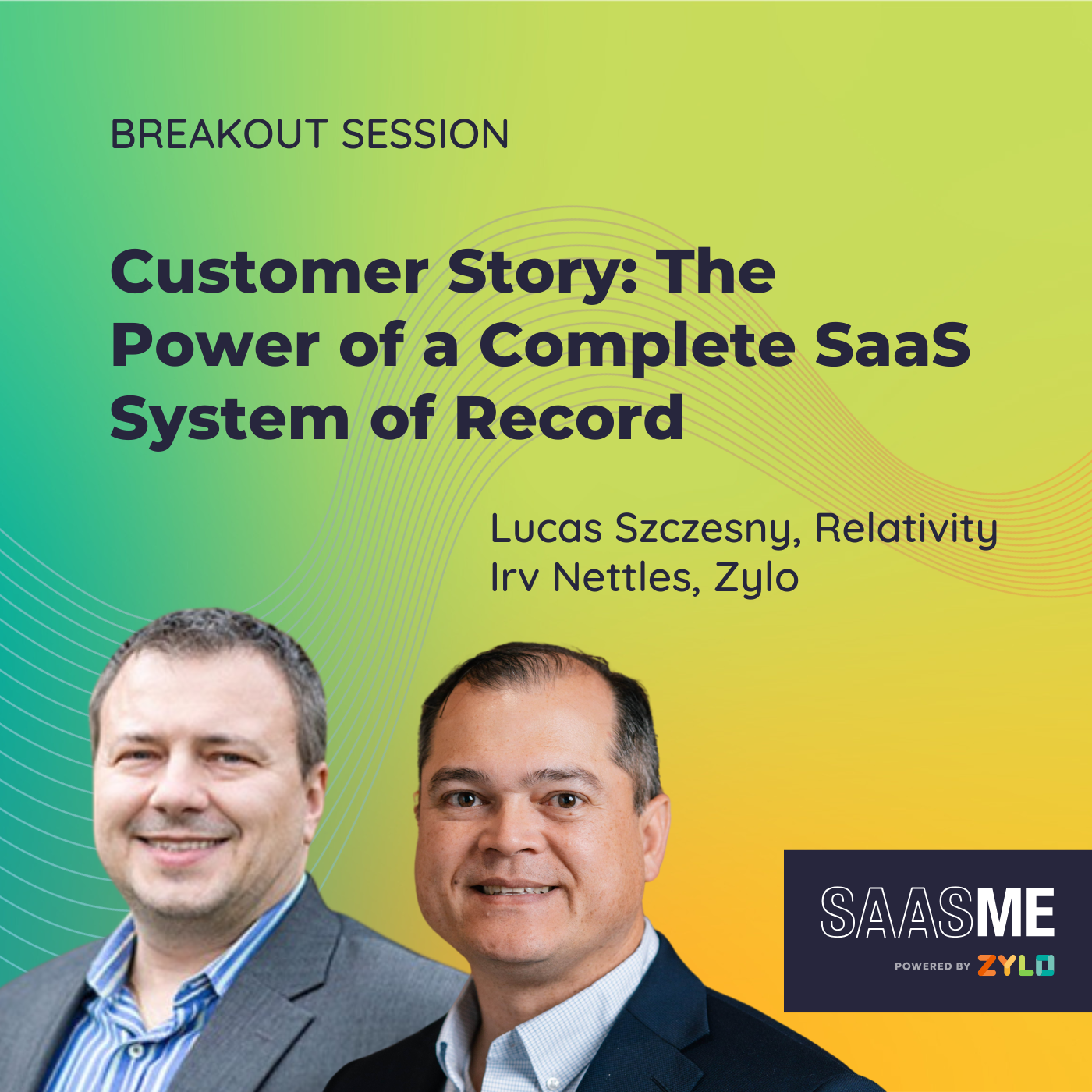Need-to-Know SaaS Trends for 2023
- 0.5
- 1
- 1.25
- 1.5
- 1.75
- 2
Ben Pippenger: All right. Welcome, everybody, to our breakout session, Need to Know SaaS Trends for 2023 and Beyond. I am super excited to be here. My name is Ben Pippenger. I am one of the co- founders here and the Chief Strategy Officer at Zylo. So what that means is I get to spend a lot of time with our customers, really understanding their key problems. I get to spend a lot of time looking at the market and understanding how we fit in, and look at insights and things that are going on. So really excited today to share with you some of this, the key SaaS trends that we're tracking for 2023. Before I jump into those trends though, I'm going to level set with y'all, looking at some data that we put together as well as some of the analysts that we track and that we spent some time with just on SaaS and what we've witnessed here in the last 12 months or so. I'm going to start with my first slide here, which really, I see this as the core foundational reason that probably a lot of us are here today, as one of the core problems that Zylo helps organizations solve, and why organizations need SaaS management and SaaS management program inside their organization. If we rewind the clock back 15, 20 years ago, the number of applications that were being purchased and used across an organization was centrally managed by IT. IT was responsible for buying those apps, that software. They were responsible for deploying that software into their data centers. They were responsible for maintaining those software titles, patching them, getting people access to those tools. Everything happened through your IT organization. Fast forward to today's world, and that has changed dramatically. We at Zylo, we put together an annual report called the SaaS Management Index. Our index came out earlier this year and it looks at the data set that we have access to. You've probably heard about it earlier today and in different sessions, and we provide insights and guidance based off that data. In this year's report, we found that from the number of applications that are purchased across the average organization, IT is only responsible for 18% of those apps. Business units are responsible for 45% of those applications, and individual employees are out purchasing and using applications, and accountable for about 37% of the apps within a company. So you can see this has been a dramatic and drastic change from the days, we often say pre- sales force where IT was responsible for everything, to today's world where IT's really responsible for about 18% of the applications within a company. Now, the other thing to remember, too, is that's where we look at today, but as we project out into the future and we think about, " Well, what's going on in the next few years?" We are looking at our analyst, Gartner, over here. Gartner puts out a quarterly global spend report that focuses on the public cloud. So public cloud would be any of the cloud- based services that organizations are purchasing today. They've inaudible a couple different segments that they look at this data by. I'm focused on the three largest here, SaaS, infrastructure as a service, and platform as a service. And you can see here the blue line at the top, that's software as a service, and this is the global spend for software as a service within organizations. In 2022, they're reporting that global spend was 167 billion dollars, 2023, 197 billion, 2024, 232 billion, and 2025, 271 billion dollars will be spent on software as a service. It is the largest segment of public cloud spend over infrastructures as a service and platform as a service. And SaaS is growing about 15 to 20 percent annually year over year. Forrester also looks at this information. Forrester is saying that by 2027, if you look at your IT budgets, software will grow to nearly half of the total technology spend. So total IT budgets, software is going to make up about 50% of that. And if we look at the organizations, we look at this data inside of Zylo and look back at the SaaS management index again, the bright side of all of this is that for the first time ever in this year's index, we actually saw organizations that have put SaaS management in place. So companies that are using Zylo decrease their application count and decrease their annual spend percentage on software. So you can see here the average organization from the SaaS Management Index has about 291 applications and they're spending about 50 million dollars on software. You can see there on the left hand side, those are broken out by different company sizes. So within your own organizations, you can figure out where you fit and what your spend and count looks like based off of the data that we've captured within the SaaS Management Index. The important thing to note here, though, is that in 2023, we actually saw a decline in the number of apps and the spend percentage. So from 2022 to 2023, the number of apps actually declined by 4% on average, and the total spend declined by 10% on average. So organizations are seeing the impact, they are seeing positive results by putting SaaS management and SaaS management program in place. All right, hopefully that helps level set where we're at, what's going on. I'll help you understand maybe the pain that you're feeling and why that pain exists. Let's jump into the key trends that we're witnessing here for 2023. I'm going to cover off on four key trends. The first one being SaaS chaos continues. Even with some of those positive indications that we're seeing some decline for those that are positively managing or putting SaaS management programs in place, the chaos really isn't going away. So let me double click into that and tell you what I mean. So we looked at this actually last year at SaaSMe. So if you joined our session last year, we highlighted the MarTec landscape, technology landscape. This is put out by chiefmartec. com. We go back to 2011, you can see that on this landscape. This is the marketing technology landscape, all the different applications that serve marketing teams. There are about 150 applications on that landscape. You can see as time progresses, that grows pretty quickly. In 2022, we reported last year the landscape had about 9, 900, 9, 900 applications on it. Now, fast forward to 2023. This is hot off the press. This just came out last week. This is the 2023 marketing technology landscape. It's so many apps in here, you can't even see what's going on. There's actually 11, 038 applications on this technology landscape. So there is just a ton of SaaS. We are continuing to see new applications, new entrants into different categories. And again, this is just the marketing technology landscape. This doesn't include any of the other parts and pieces and departments and groups within your organizations that are using software today. Next we're going to look at another analyst, IDC. IDC put together this spend guide. It's similar to what we were reporting earlier with Gartner and Forester, where they're looking at global spend for software. They're projecting out on- premise software, so legacy on- premise software that you're deploying into data centers. You can see this is their growth curve here for on- premise through 2026. When we layer on top their growth curve for SaaS, you can see that that's growing very quickly. And they reported that in 2022, that was the first time that they've seen cloud software overtaking on- premise software from a spend perspective. And that is going to continue to grow. And they're reporting by 2026, that's actually going to be two thirds of spend will be on cloud- based software versus on- premise. So we are still in the digital transformation period. We're still seeing a lot of organizations moving to SaaS off of on- premise. That will continue to happen for the foreseeable future. And the last point to make here on SaaS cloud chaos is one that you all probably have felt in recent days, and that is AI and machine learning. So AI and machine learning, it's here. We are starting to see it be embedded into really every application that's out there. You can see a collection of apps that are highlighted on this screen that have already put AI, it's core parts into their product or working to put them into their product. But what you can expect is that every application that you have is going to have an AI or ML strategy into those existing tools. On top of that, you're going to have a whole bunch of new entrants that are going to be hitting your radar that employees are going to be wanting to purchase, that department heads are going to be wanting, that you have to start to get your head around. So it's the explosion of the number of SaaS applications and the capabilities that these applications provide is going to continue. All right, so let's look at some key recommendations here for trend number one. Trend number one being the SaaS chaos continues. Number one, you have to get a complete and ongoing understanding of your SaaS inventory. This is paramount. If you don't know what's out there, you have no way to understand what's going on and the chaos is going to continue. Next, once you know what you got, make sure you're conducting a rationalization exercise to understand where there's opportunity to streamline. You can start to get control of this chaos by getting that visibility and putting a system and tools in place to really drive some change within your organization. And then number three, make sure you're staying ahead of AI and other innovations that are happening to really understand your organization's needs as well as to combat any future SaaS inaudible. Make sure you're staying on top of that in order to not be caught in the same situation again in the future. All right, so SaaS chaos continues, trend number one. Let's move on to our second trend, which is SaaS prices are increasing. We're continuing to see prices go up, and I'm sure a lot of you in our session today are feeling this as you're going out and renewing and talking to your different SaaS vendors that you work with. So we're going to look to Gartner here. This is from a report they put out last August, August, 2022, called Three Reasons Why SaaS Vendors Are Rising prices, Raising Prices, excuse me, and what you can do about it. They are projecting that by 2025, the combined impacts of inflation, competitive labor markets, and environmental sustainability requirements will lead to a 15 to 20 percent increase in SaaS costs across the board. So that is an impactful number. That is something that y'all should be thinking about and you should be looking at. I'm sure you're already feeling, as I said earlier, when you're talking and working with your SaaS vendors as part of your renewals or purchasing processes. So what should you do about this? Well, I turned to our own experts here at Zylo. We have a team of SaaS negotiators that work with our customers on their behalf to inquire about are they seeing this? What sort of things are they doing about this? And they are definitely experiencing this. They're seeing this on the regular when they're going out and helping our customers renew their SaaS contracts. And they really provided me with five key recommendations for things that y'all should be doing or that they're doing to help combat this. Number one, make sure that you're leaning heavily into your existing partnership that you've built with your SaaS vendor. So I'm assuming you've got good relationships here and you've built successful partnership with this vendor. Really lean into that relationship, into that successful partnership, and make sure that you're both getting mutual value here and the right amount of mutual value for the price that you're paying for that application. Number two, make sure you're looking at industry standard pricing benchmarks. What are others like you that are buying the same products, the same number of licenses or similar number of licenses, paying for that product? And use that as information as you're working and talking with your vendors. Number three, if pricing is going to be a big challenge, make sure you're exploring other incentives that your SaaS vendor may be willing to negotiate on outside of price. For instance, multi- year deals. If you're able to sign a multi- year contract that either locks in at your current, or even better, a lower rate, that is for sure something you should be looking at in order to make sure that you've got your prices and costs under control. Number four, y'all have budgets. Those budgets are typically set and forecasted throughout the year. That can definitely put a constraint on price increases year over year. So make sure that you understand what your budgets look like, make sure that you're leveraging those budgets and using those in your conversation with your vendor to get the right price for your application. And then number four, on an ongoing basis, really make sure you have price caps in place, whether that's in your MSA with your vendor, or where that needs to exist so that every year you're not forced with these price increase, you can put some controls in place to make sure things are reasonable for your organization. All right, that is trend number two. SaaS prices are going up, prices are increasing. Trend number three is around license waste. Trend number three is license waste proliferates. It is a problem that we see. We see it all the time, we help organizations with. It's also a problem that we report on inside of our SaaS management Index. So we're going to turn in there again to look at the trend numbers and what we're seeing based off of the data that's in the index. And it's pretty substantial. It's pretty eye- opening, actually, when you really look at this holistically from a macro level view and see how many licenses are actually being wasted. We have found that on average, 44% of SaaS licenses are wasted. That's more than 17 million dollars on average within organizations that are wasted from SaaS licenses. So in this graph down here, you can see we're showing that across the different segments, 1 to 500 employees, 500 to 2500, and then up to the global enterprise level of 10,000 employees and up. And I think an interesting thing you can see here, as organizations get bigger, the waste percentage gets larger and larger. And so you can attribute that to just the fact that there's more apps, there's more complexity, there's more data that you have to be looking at to really understand what your waste looks like. And what we really recommend at Zylo is that we want to help organizations strive to get a 90% active user, active license calculation for any application. You should keep about 10% in order to help with any buffer that you may need, but that's really what you should be striving for. And there's a lot of ground to make up here from 44% of license waste down to a 10%. So huge opportunity here for organizations to really map into this and get going. So how do you do that? What are some recommendations that you can take forward here? Number one, start with your largest apps and work to really understand your license position. What do those contracts look like? Who has access? Who's using? What's their usage look like? And then start to put a program in place. Number two, ensure former employees or contractors that are no longer with your organization don't have access to your applications. Number one, it's a waste even if they can't access those tools anymore if it's behind single sign- on, but you're wasting those licenses. And number two, it's a potential security risk if they can still access those tools through different ways, to make sure you're staying on top of that and pulling back those licenses. Number three, put a program and process in place to regularly reclaim unused licenses from your employees. Make sure you're looking at usage. Make sure you're calculating what usage needs to be and what it looks like, and pulling those licenses back, especially before you go buy more or before you renew those software titles. And then lastly, keep to that or try to keep to that 10% license buffer to make sure that you have at least some wiggle room to support ebbs and flows within the business. All right, one more to round out our key trends for 2023, is that SaaS compliance is a must. It is not a nice to have. It is a must have. And the key reason for that that we focus on here at Zylo is due to shadow IT. Shadow IT remains a challenge for organizations. So we looked at this earlier, we showed the about 37% of applications within an organization are bought by employees. That's the shadow IT number here that we're looking at. 15% of employees within your organizations are buying software and expensing it on corporate credit cards. So why is this a problem? Why is this an issue and why is it something that you should be focused on? Well, number one, it can cause a lot of wasted time and wasted effort for your IT teams if they find themselves having to support, field questions, understand applications that they may just be unaware of or don't have the expertise to be able to properly support and they've got to go research and figure out what's going on, how'd this application get in your environment, and try to answer your end user's questions. Number two is that small dollar applications that maybe an employee goes and purchases for 10, 15, 20 dollars a month can turn into large dollar apps very, very quickly that you're not forecasting for, there's no budget for. So making sure you're staying on top of that is paramount. And then number four, there's potential for unknown risks here. If employees are using applications that haven't gone through the proper reviews, you could be putting your company at risk by putting sensitive data up into those applications. Gartner stated last year that organizations that don't get their arms around a complete understanding of their SaaS applications are five times more susceptible to a cyber incident. So it is a must have as you start to plan for these things. So what recommendations do we have here for SaaS compliance becoming a must? Number one, shadow IT isn't necessarily a bad thing, but you need to understand what it is, what applications are entering your environments, and just get a handle on it so that you can stop things before they get out of hand. Number two, make sure you're giving your employees the ability to find tools that are IT approved and you're giving them an easy way to access and request those tools so they can start using them. Lots of times, employees just don't even know what's available to them. So giving them a place to go to see that, find the tools they need, and have a clear way to get access to those tools can really help combat shadow IT. And then the third recommendation is there's going to be times when an employee can't find the tool they need. Maybe they have a specific tool or you haven't introduced that capability into your overall inventory of SaaS applications. Make sure you have a clear, easy, and a clear way for them to request access or request the purchasing of that application. So make sure that they know where to go to buy it, they can understand the approval process that that application needs to go through to purchase that application, and that can really help combat them going out and just buying it themselves. So as we wrap up here, Top Need to Know SaaS Trends for 2023, number one, SaaS chaos continues. Best thing you can do here is get your SaaS in gear, get visibility to what's going on. Number two, SaaS prices are going up. Negotiation is a must for renewals. Number three, licensing waste proliferates. Strive for that 90% active license metric. And number four, SaaS compliance becomes a must. Manage IT and remove barriers for your employees to get access and visibility to those tools. All right, thank you. Really appreciate your time. Enjoy SaaSMe and don't be a stranger. We'll see you around. Thanks.
DESCRIPTION
SaaS is now woven into the fabric of most organizations – from accounting tools to web conferencing, modern businesses run on SaaS. Yet, the world of SaaS is constantly changing as new vendors, pricing models and more emerge. Join our resident SaaS expert Ben Pippenger as he shares his top SaaS trends to be aware of in the year ahead.
Today's Guests








